Dealing with car damage can throw a wrench into your daily life. Beyond the immediate stress of the incident, one of the first questions that pops into your mind is likely: “How long will my car be in the shop?” Whether it’s a minor fender bender or significant collision damage, understanding the repair timeline is crucial for managing your expectations and making necessary arrangements for alternative transportation.
At Car Repair Online, we understand that getting your car back on the road quickly and efficiently is a top priority. That’s why we’ve created this comprehensive guide to answer your key question: how long does it take to repair car damage? We’ll break down the typical repair times, explore the various stages involved in the process, and shed light on the factors that can influence how long you’ll be without your vehicle. Knowing what to expect can significantly reduce the stress associated with car repairs and help you navigate the process with confidence.
Average Car Repair Durations: What to Expect
If you’re looking for a straightforward answer to “how long will car repairs take?”, the truth is, it varies widely. The average timeframe for auto body repair can range from just a few hours to several weeks, or even longer, depending on the extent of the damage and a number of other variables.
To give you a clearer picture, we’ve compiled a table outlining typical repair times for different types of car damage. Keep in mind these are averages, and your specific situation may differ.
| Type of Collision Repair | Average Time to Fix |
|---|---|
| Minor Collision Repair | 1-3 days |
| Major Collision Repair | 1 to 3 weeks |
| Paintless Dent Repair | 1-2 days |
| Bumper Repair/Replacement | 1-3 days |
| Fender Repair/Replacement | 1-4 days |
| Door Repair/Replacement | 2-4 days |
| Glass Replacement | 1-2 days |
| Suspension Repair | 2-3 days |
| Frame Straightening | 4 days – 2 weeks |
| Paint Repair (minor) | 2-4 days |
| Paint Repair (major) | 1-2 weeks |
| Airbag Replacement | 2-5 days |
| Engine Repair/Replacement | 1-4 weeks |
| Full Vehicle Restoration | 4-8 weeks or longer |
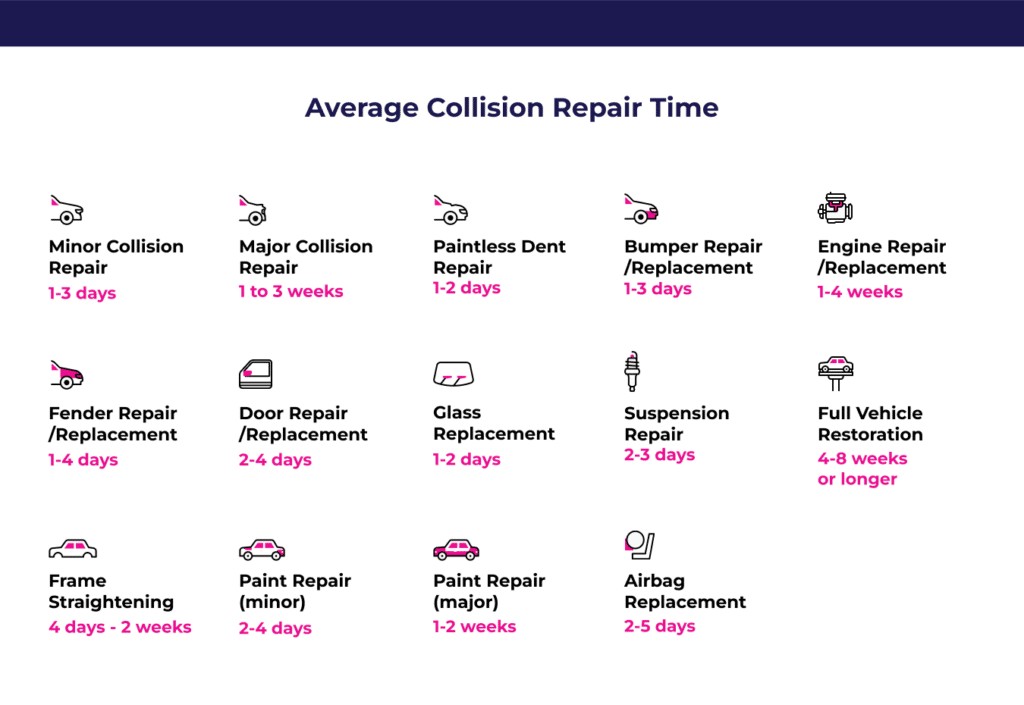

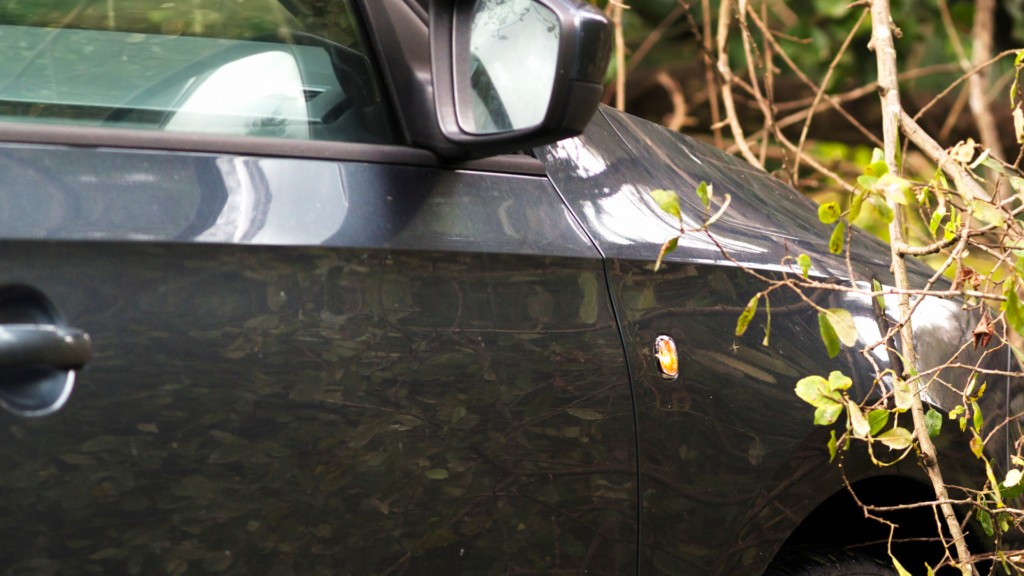
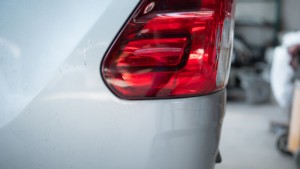
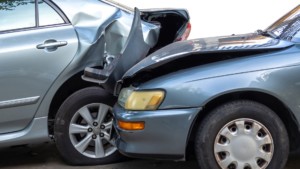
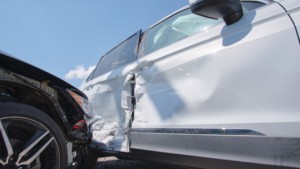
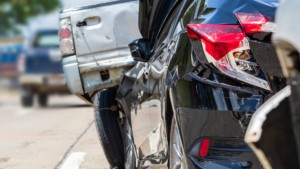
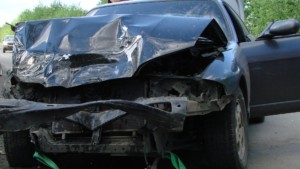


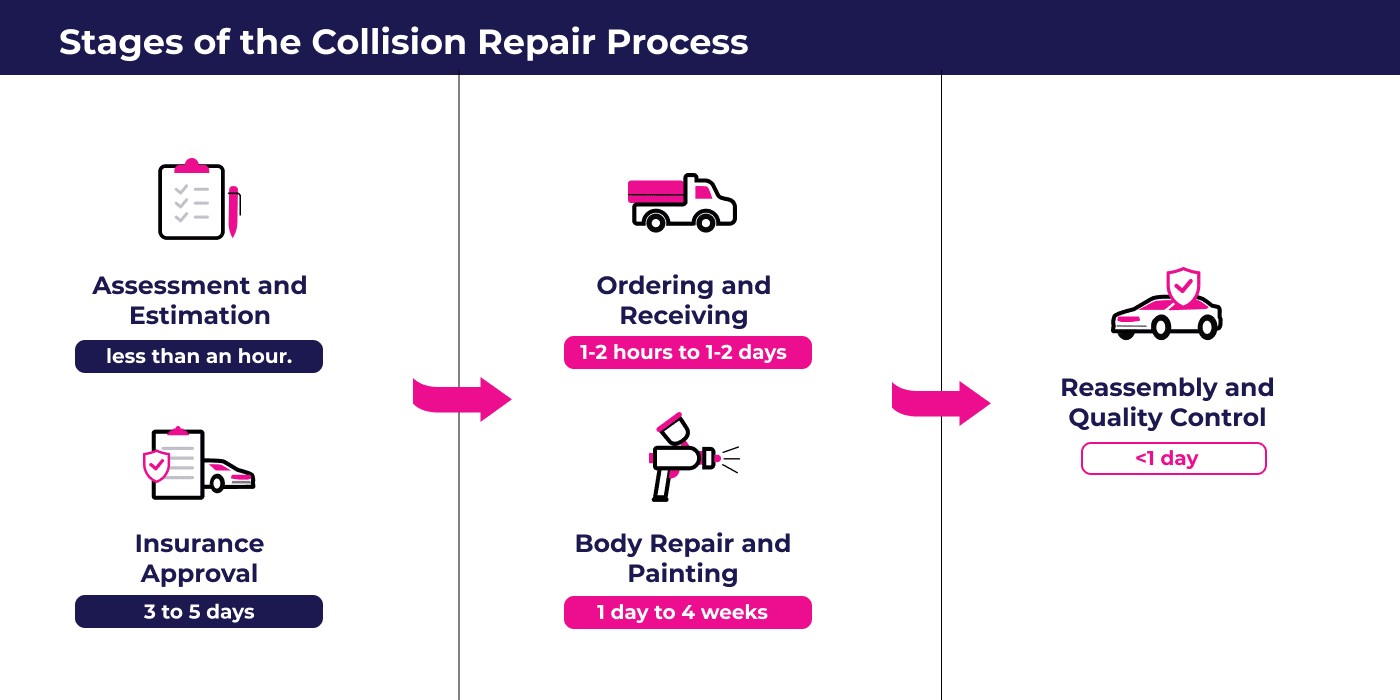
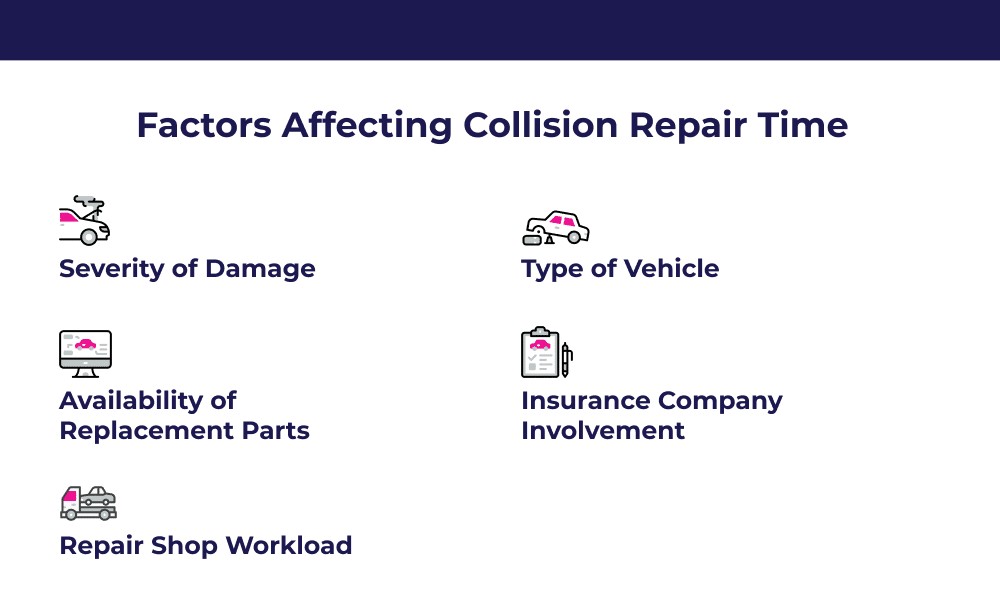
As you can see, the range is significant. Let’s delve deeper into the differences between minor and major collision repairs to better understand these timeframes.
Understanding Minor vs. Major Car Damage Repair Time
The distinction between minor and major collision repair is crucial in determining the expected repair duration. Generally, repairs are categorized based on the severity and complexity of the damage.
Minor Collision Repair: Quick Fixes
Minor collision repairs are typically completed within 1 to 3 days. These types of repairs address cosmetic damages that don’t affect the structural integrity or major systems of your vehicle. They often involve straightforward fixes such as:
- Small dents: Like those from runaway shopping carts or hail.
- Scratches: Superficial paint damage from branches or minor abrasions.
- Minor bumper damage: Scuffs, scrapes, or small cracks.
These repairs are quicker because they are less labor-intensive and usually don’t require extensive part replacements or complex procedures. With the right tools and skilled technicians, the actual repair work can often be completed in a few hours.
Examples of Minor Collision Damage:
- Shopping Cart Collision
- Tree Branch Scratches
- Minor Scratches from Road Debris
Major Collision Repair: More Extensive Work
Major collision repairs, on the other hand, can take anywhere from 1 to 3 weeks to complete. These repairs involve more substantial damage that affects the vehicle’s structure, mechanics, or safety systems. Examples of major collision damage include:
- Frame damage: When the car’s structural frame is bent or misaligned.
- Mechanical problems: Damage to the engine, transmission, suspension, or other critical systems.
- Airbag deployment: Requiring replacement of airbags and related sensors.
- Significant body panel damage: Extensive damage to doors, fenders, or quarter panels.
Major repairs require specialized equipment, skilled technicians, and often involve waiting for parts to be ordered and delivered. The complexity of the work and potential for unforeseen issues contribute to the longer repair timeframe.
Examples of Major Collision Damage:
- Rear-End Collision
- Side-Impact (T-Bone) Collision
- Parking Lot Collision with a Pole or Barrier
Severe Collision Damage: Extended Repair Times
In the most severe cases, car damage repair can extend beyond 3 weeks. This typically occurs when there is:
- Extensive frame damage: Requiring significant straightening or even frame replacement.
- Hard-to-find parts: For older, rare, or luxury vehicles, parts procurement can take considerable time.
- Complex mechanical repairs: Major engine or transmission work.
The more extensive the damage, the more time and resources are needed for proper and safe repairs.
Examples of Severe Collision Damage:
- High-Speed Head-On Collision
- Rollover Accident
- Severe Side-Impact (T-Bone) Collision at High Speed
Decoding the Timeline: Stages of Car Damage Repair
To better understand why car repairs take the time they do, it’s helpful to understand the typical stages involved in the collision repair process. From the initial assessment to the final quality check, each step contributes to the overall timeline.
Initial Assessment and Estimate
The first step in any car damage repair is a thorough assessment of the damage. A qualified repair technician will inspect your vehicle to determine the extent of the damage, identify all necessary repairs, and prepare a detailed estimate. This estimate will outline the cost of parts, labor, and the anticipated repair timeframe.
Timeframe: While some shops may take a day or more to provide a comprehensive estimate, Car Repair Online prioritizes efficiency and aims to provide free estimates in a timely manner.
Insurance Claim and Approval
If you’re filing an insurance claim to cover the repairs, the estimate must be submitted to your insurance company for review and approval. The insurance adjuster will evaluate the estimate to ensure the proposed repairs are necessary and the costs are reasonable according to industry standards and your policy coverage. This process may involve some negotiation between the repair shop and the insurance company.
Timeframe: Insurance approval can typically take 3 to 5 business days, but it can sometimes be longer depending on the complexity of the claim and the insurance company’s processes.
Parts Ordering and Procurement
Once the estimate is approved, and depending on the damage, the repair shop will likely need to order replacement parts. The time it takes to receive parts depends on several factors, including:
- Part availability: Common parts are usually readily available, while specialized or rare parts may need to be ordered from manufacturers or suppliers further away.
- Vehicle make and model: Parts for popular vehicles are generally easier to source than those for luxury or less common models.
- Shipping times: Delivery distances and supplier locations impact shipping duration.
Timeframe: Parts ordering can range from a few hours to 1-2 days, but in some cases, especially for back-ordered or hard-to-find parts, it can take longer.
Body Repair and Painting
This is the core of the collision repair process. Technicians will perform the necessary bodywork, which may include:
- Dent removal: Using specialized techniques to restore damaged panels to their original shape.
- Panel replacement: Removing and replacing severely damaged panels like fenders, doors, or bumpers.
- Frame straightening: Using advanced equipment to correct frame damage and ensure structural integrity.
- Welding and fabrication: Performing structural repairs as needed.
After the bodywork is complete, the vehicle will undergo painting. This involves preparing the surfaces, matching the paint color, applying primer, base coat, and clear coat, and ensuring a seamless finish.
Timeframe: Body repair and painting can take 1 day to 4 weeks or longer, depending on the extent of the damage, the complexity of the repairs, and the need for specialized paintwork.
Reassembly and Quality Check
Once the painting is complete and cured, the vehicle is reassembled. This involves reinstalling trim pieces, moldings, lights, and other components that were removed during the repair process. Finally, a thorough quality control inspection is performed to ensure all repairs meet high standards, all systems are functioning correctly, and the vehicle is safe to drive.
Timeframe: Reassembly and quality control typically take 1 to 2 days.
Potential for Additional Delays
It’s important to be aware that unforeseen issues can arise during the repair process, potentially extending the timeline. These can include:
- Discovery of hidden damage: Once panels are removed, technicians may uncover additional damage not visible during the initial assessment.
- Need for specialized repairs: Some vehicles may require specialized repairs like advanced electronic system calibrations or unique repair procedures.
- Supply chain disruptions: Global events or regional issues can sometimes impact parts availability and delivery times.
Key Factors Influencing Car Repair Duration
Several factors can significantly impact how long it takes to repair car damage. Understanding these factors can help you anticipate the potential repair timeline for your vehicle.
Severity of Damage
As discussed earlier, the severity of the damage is a primary determinant of repair time. Minor scratches and dents will naturally take less time to repair than major frame damage or extensive mechanical repairs. The cost of repairs also correlates with the severity of damage, ranging from a few hundred dollars for minor fixes to tens of thousands for major collisions.
Parts Availability
The availability of replacement parts is another critical factor. Common parts for popular vehicle models are usually readily accessible, leading to faster repair times. However, if your vehicle requires rare, specialized, or back-ordered parts, the repair process will inevitably be delayed. The choice between Original Equipment Manufacturer (OEM) parts and aftermarket parts can also influence availability and potentially repair time.
Vehicle Type
The type of vehicle you drive also plays a role. Common vehicles from brands like Toyota, Honda, Ford, and Chevrolet generally have readily available parts and established repair procedures, leading to quicker and often more affordable repairs. Luxury or rare vehicles, such as Mercedes-Benz, BMW, Audi, Lexus, and Tesla, often require specialized parts, trained technicians, and potentially longer repair times.
Insurance Involvement
When insurance is involved, the claims process, including estimate approvals and potential negotiations, can add time to the overall repair timeline. While insurance coverage is essential for managing repair costs, it’s important to factor in the time required for claim processing. Choosing a repair shop that is experienced in working with insurance companies, like Car Repair Online, can help streamline the process and minimize delays.
Repair Shop Workload
The workload of the chosen auto repair shop can also influence repair time. During peak seasons or if a shop is experiencing high demand, there may be a waiting period before repairs can begin, and the overall turnaround time might be extended. Selecting a reputable and well-staffed repair shop can help ensure efficient service and minimize delays due to workload.
Conclusion
So, how long does it take to repair car damage? As we’ve explored, the answer is multifaceted and depends on a range of factors. From minor touch-ups to major collision repairs, the timeframe can vary from a few hours to several weeks. Understanding the stages of the repair process and the factors that influence repair time can empower you to manage your expectations and navigate the experience with greater ease.
While it’s natural to want your car back as quickly as possible, remember that quality repairs take time. Patience and open communication with your chosen repair shop are key. By selecting a reputable and experienced provider, you can ensure a smooth, reliable, and ultimately satisfactory car damage repair process, getting you safely back on the road.
FAQs: Understanding Car Repair Timelines
What do I use for transportation while my car is in the shop?
Finding alternative transportation is a common concern when your car is undergoing repairs. Many insurance policies offer rental car coverage, so it’s worth checking your policy details. Some repair shops also offer loaner vehicles or assistance with rental arrangements. Car Repair Online aims to minimize disruption by offering convenient solutions for transportation needs during the repair period.
Do you offer an automotive repair warranty?
Yes, reputable auto body shops stand behind their work. Car Repair Online offers a comprehensive warranty on our auto body and collision repair services, providing you with peace of mind and assurance in the quality of our workmanship.
How long does it take to fix a front-end collision vs. rear-end collision?
While each collision is unique, rear-end repairs are often, but not always, quicker and less expensive than front-end repairs. The front of a vehicle typically houses more complex components like the engine, radiator, and intricate grill work, which can lead to more extensive and time-consuming repairs in front-end collisions.
When is my car considered a total loss?
A car is typically considered a total loss when the cost of repairs exceeds a certain percentage of the vehicle’s actual cash value (ACV). This threshold often ranges from 70-75% of the ACV, but it can vary by insurance company and state regulations. If your car is deemed a total loss, the insurance company will typically pay you the ACV of the vehicle, and you may have the option to retain the salvage rights.
What do I do if it’s taking much longer than originally estimated?
If your car repair is taking significantly longer than initially estimated, the first step is to communicate directly with your repair shop. Inquire about the reason for the delay. It could be due to unforeseen issues like hidden damage, parts delays, or insurance claim complications. Open communication can help clarify the situation. If you remain concerned, you can also contact your insurance adjuster for updates and to explore options if necessary.
How much does collision repair cost?
Similar to repair time, collision repair costs are highly variable depending on the extent of damage, vehicle type, parts needed, and labor rates. Obtaining a free and detailed estimate from a reputable repair shop like Car Repair Online is the best way to understand the potential costs involved in your specific situation.
